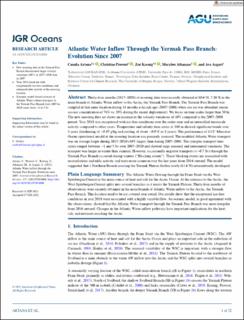| dc.contributor.author | Artana, Camila | |
| dc.contributor.author | Provost, Christine | |
| dc.contributor.author | Koenig, Zoe Charlotte | |
| dc.contributor.author | Athanase, Marylou | |
| dc.contributor.author | Asgari, Ava | |
| dc.date.accessioned | 2022-06-08T12:44:39Z | |
| dc.date.available | 2022-06-08T12:44:39Z | |
| dc.date.created | 2022-05-04T13:55:58Z | |
| dc.date.issued | 2022 | |
| dc.identifier.issn | 2169-9275 | |
| dc.identifier.uri | https://hdl.handle.net/11250/2997946 | |
| dc.description.abstract | Thirty-four months (2017–2020) of mooring data were recently obtained at 80.6°N, 7.26°E in the main branch of Atlantic Water inflow to the Arctic, the Yermak Pass Branch. The Yermak Pass Branch was sampled at that same location during 14 months a decade ago (2007–2008) when sea ice was abundant (mean sea-ice concentration of 74% vs. 39% during the recent deployment). We focus on time scales larger than 50 hr. The new mooring data set shows an increase in the velocity variations of 40% compared to the 2007–2008 period. Year 2018 was exceptional with ice-free conditions over the entire year and an intensified mesoscale activity compared to other years. Temperature and salinity time series at 340 m showed significant trends over 3 years (freshening of −0.07 g/kg and cooling of about −0.9°C in 3 years). The performance of 1/12° Mercator-Ocean operational model at the mooring location was precisely assessed. The modeled Atlantic Water transport was on average larger during 2017–2020 (40% larger) than during 2007–2008. The synoptic transport time series ranged between −1 and 5 Sv over 2007–2020 and showed large seasonal and interannual variations. The transport was larger in winter than summer. However, occasionally negative transport (<−0.7 Sv) through the Yermak Pass Branch occurred during winters (“Blocking events”). These blocking events are associated with recirculations and eddy activity and were more common over the last years from 2016 onward. The model suggested that a Northern Branch crossing the Yermak Plateau further north (81.6°N) intermittently developed. | en_US |
| dc.language.iso | eng | en_US |
| dc.publisher | AGU | en_US |
| dc.title | Atlantic Water Inflow Through the Yermak Pass Branch: Evolution Since 2007 | en_US |
| dc.type | Journal article | en_US |
| dc.type | Peer reviewed | en_US |
| dc.description.version | publishedVersion | en_US |
| dc.rights.holder | Copyright 2022 American Geophysical Union. All Rights Reserved | en_US |
| dc.source.articlenumber | e2021JC018006 | en_US |
| cristin.ispublished | true | |
| cristin.fulltext | original | |
| cristin.qualitycode | 2 | |
| dc.identifier.doi | 10.1029/2021JC018006 | |
| dc.identifier.cristin | 2021450 | |
| dc.source.journal | Journal of Geophysical Research (JGR): Oceans | en_US |
| dc.identifier.citation | Journal of Geophysical Research (JGR): Oceans. 2022, 127 (2), e2021JC018006. | en_US |
| dc.source.volume | 127 | en_US |
| dc.source.issue | 2 | en_US |
